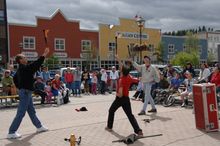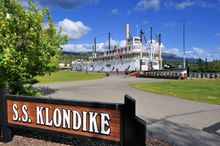 26 Jun 2025
26 Jun 2025
Whitehorse, the capital of Canada's Yukon Territory, has launched a new Downtown Public Art Map for 2025 featuring more than 80 outdoor installations, murals, mosaics, and bronze busts across the city. The expanded self-guided walking tour highlights Whitehorse's thriving creative community and Indigenous heritage, inviting visitors to explore the city's streets, riverfront, and parks through a cultural lens.
Produced in collaboration with local artists, the City of Whitehorse, and arts organisations, the updated art walk is divided into three zones, each offering its own unique blend of storytelling, sculpture, and visual surprises. Each section takes around 45 minutes to an hour to complete at a relaxed pace, with the full trail comfortably explored in three hours, including ample time for stops, photo opportunities, and cultural moments along the way.
Main Street to LePage Park: Murals, Busts and Community Icons
The downtown section features 35 public art installations and eight bronze busts, including tributes to poet Robert Service and Tagish elder Angela Sidney. Sculptures like “The Horse of Whitehorse” by Daphne Mennell—crafted from over 200 pieces of community-donated metal—capture the spirit of Whitehorse's people and past. Notable murals include Erin Dixon's “Seasons of the River” (2021), a seasonal tribute to the Yukon River, and Ken Anderson's “Diversity and Inclusion in a Time of Change” (2022), which reflects his Tlingit and Scandinavian heritage through steel geometry. LePage Park is also home to the city's beloved Arts in the Park festival, a long-running summer tradition of live performances and visual exhibitions.
Rotary Park to The Wharf: Storytelling Along the Waterfront
The riverside stretch between Rotary Peace Park and The Wharf features 20 public art installations that bring together cultural storytelling and landscape design. “Raven Steals the Sun” by Stan Peters and Philippe Leblond anchors Rotary Park with its depiction of a well-known Tlingit legend. Further along, the 11-metre Healing Totem—carved by youth from the Northern Cultural Expressions Society in 2012—stands facing the river, symbolising healing and reconciliation. Interpretive signage throughout the trail provides deeper context into each piece and the heritage it represents.
Shipyards Park and East End: Sculptures, Symbols and Seasonal Art
Shipyards Park and the eastern edge of downtown feature 19 installations, including a mixture of permanent sculptures and interactive works. “Box of Light” by Ken Anderson is a standout—a glowing sculpture inspired by the Tlingit story of Raven bringing light to the world. Other highlights include “River Walk” by Joyce Majiski, “Yukon Workers Memorial” by Béla Simó, and “Raven's House” by Alyx Jones. This park can be explored in all seasons, with a bike track that transforms into a skating loop in winter.
Explore the Map and Local Galleries
Maps are available from the Whitehorse Visitor Information Centre and can be downloaded via the Travel Yukon website here. For those looking to delve deeper into Yukon's creative heart, several galleries line the walking route, each offering its own perspective on northern art and culture. Arts Underground, located on Main Street, is home to the Yukon Art Society and hosts rotating exhibitions, artist studios, and public workshops, including a ceramic studio open to visitors. A short walk away on Third Avenue, Yukon Artists @ Work operates as a member-run co-operative gallery showcasing the work of over 30 Yukon-based artists. On Front Street, North End Gallery presents a striking collection of northern fine art, sculpture, and Indigenous jewellery. Nearby, Lumel Studios invites visitors into a vibrant glass-blowing studio where daily demonstrations and hands-on experiences are available. The riverfront Kwanlin Dün Cultural Centre, set against a backdrop of traditional lands, features powerful exhibitions and performances that celebrate the heritage of the Kwanlin Dün First Nation. Just a few blocks away, the Old Log Church Museum offers a more historic perspective, featuring early artefacts, historic photographs, and faith-inspired artwork that offer insight into Whitehorse's early community life. These indoor spaces provide a year-round extension to the outdoor trail—offering visitors an even deeper connection to the Yukon's artistic and cultural soul.
About Yukon
Tucked into Canada's far Northwest corner, beside Alaska, the Yukon is the country's most accessible northern destination. It's home to Canada's highest mountain, Mount Logan, and the planet's largest non-polar icefields—found in Kluane National Park, a UNESCO World Heritage Site. Despite its scale, Yukon remains one of North America's best-kept secrets: nearly 80 percent of the territory is untouched wilderness. Picture 5,000-metre peaks, forested valleys, crystal-clear waters, and vast wildlife corridors. Roughly the size of Spain at just over 186,000 square miles,it's home to 220,000 caribou, 70,000 moose, 22,000 mountain sheep, 7,000 grizzly bears, 10,000 black bears, and 250 bird species… all shared by a human population of just 46,000.
Take me to the Yukon this summer with Wexas:
Wexas offers an 11-day Yukon's Summer Highlights package from £2725 per person. Price includes return international flights from the UK to Whitehorse, car hire, nine nights hotel accommodation, and admission to Yukon Wildlife Preserve. To book, visit https://www.wexas.com/itinerary-offers/discover-the-yukon-104118 or call 020 8125 4263.
For further information on the Yukon, visit www.travelyukon.com





